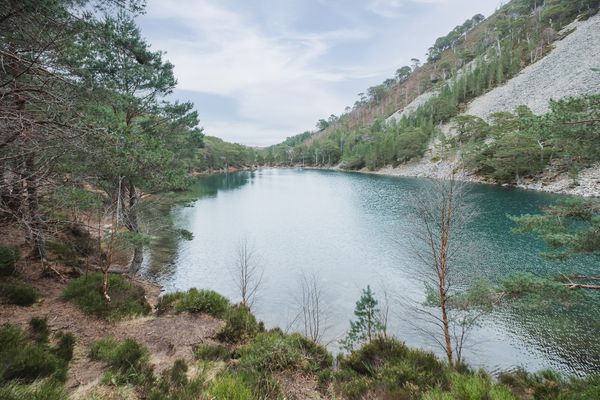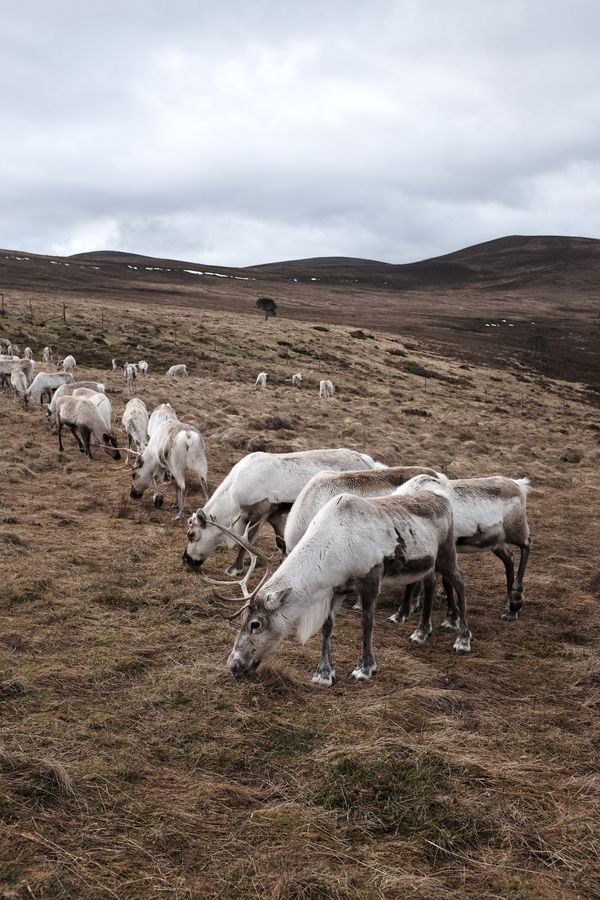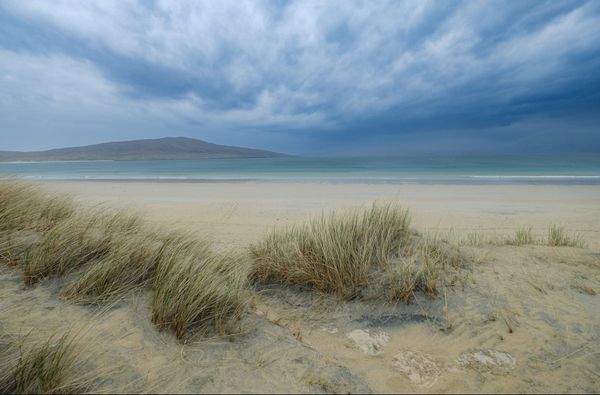It’s estimated that there have been 3,000 castles in Scotland throughout history, as the homes of clan leaders and for defensive purposes, though only hundreds of those are still standing today. Arguably one of the most famous is Balmoral – the Scottish holiday residence of the Royal family. Having grown up in England, we’ve seen countless images from Balmoral on the news over the years, as Royals come and go or flowers are laid at the front gates by the public after the passing of a Royal family member. People from across the UK and the world will have an image in their minds of what it’s like to visit a Royal castle – us included! So while road-tripping our way around Scotland earlier this Spring, we had to go and see it for ourselves. Here’s what to expect when visiting Balmoral:
Table of Contents
Where is Balmoral?
Balmoral Castle and estate is situated in Ballater, Aberdeenshire. There is limited public transport to the Castle, though there is a spacious car park. From the car park it’s just a few minutes walk across a bridge to the ticket office at the main gate. Interestingly, this wrought-iron girder bridge is the only structure in Scotland designed by Isambard Kingdom Brunel. See our map below for directions to the Balmoral estate.
How can I visit Balmoral?
Balmoral estate is open to the public from April to July each year. We were lucky that our visit to the area coincided with the opening day on April 1st! It’s not possible to see the Castle from the road, so the only way to see the Castle and tour the estate is by purchasing tickets. Visitors can buy tickets on the gate, but we’d highly recommend doing as we did – purchasing tickets ahead of time online. This means you’ll receive a complementary audio guide with your tickets which usually costs an additional £5 when purchased on the door.
It’s worth noting that the price of your ticket does not include parking, which must be purchased separately via machines in the car park on the day. In total we paid £16.50 each for our entry tickets to the estate, plus £5 for parking which is charged at a flat all-day rate for both cars and campervans. For those in campervans, there is the option to purchase overnight parking for £10, or to upgrade your £5 day parking ticket to an overnight one if you decide last minute to stay the night! We had planned to do so ourselves but found only 2 of the 6 dedicated motorhome spaces were on level ground, with the rest slightly sloping. In the end we opted to move on and park somewhere quieter, with fewer tourists coming and going. You can find up-to-date ticket prices on the Balmoral website.
What is there to see at Balmoral?
As soon as you walk through the main gates into the Balmoral estate, the audio guide begins to accompany your journey up the long path towards the Castle. Our biggest piece of advice we have for visiting Balmoral is to say yes to the audio guide! We never usually rent audio guides when we visit attractions, but we honestly think visitors will have a much more valuable experience at Balmoral with this guide. There is no signage around the estate, and the only way we knew which way to go was by consulting the map that was given to us when we picked up our tickets at the main gate. Even with the map, there are no information boards at any of the points of interest and it would be impossible to know the significance of these without the audio guide. The guide is available in English with Dutch, French, German, Italian and Spanish translations. If, as we did, you listen to the English guide, you’ll be treated to a speaker with rich Scottish accent which only added to our magical Scottish tour of the estate!
Following the numbers that correspond with the audio guide, we first visited the kitchen garden where we learned that it was the late Prince Philip who designed and planted the gardens here. We also saw a quote in embellished font etched into the glass on the side of a garden conservatory, which we learned was a gift from the Balmoral staff to the Queen to commemorate her Golden Jubilee in 2002. The garden itself was a little bare as we visited quite early in the Spring, but we’re sure it’s beautifully abundant with veggies later in the year!
As we made our way out of the kitchen garden, we were treated to our first full view of the Castle as we stood by decorative gates with gold GR and MR insignia. From here visitors can really see how impressive the Castle is! On our way to see it up close we passed the Garden Cottage, where the audio guide told us Queen Victoria used to take her breakfast and write her diaries. Arriving at the Sunken Garden, just by the gates of the Castle, we saw the Foundation Stone that Queen Victoria herself laid at the beginning of the Castle’s construction.
While your ticket grants entry to the Balmoral estate grounds, it is not possible for the public to take a tour inside the Castle. Only the Ballroom is open to visitors as it features an exhibition that changes each year, though photography is not permitted inside. During our visit in 2023, the exhibition focused on celebrating the life of the late Queen Elizabeth II, as well as the coronation of King Charles III, through a photographic display of Royal Monarchs at Balmoral from Queen Victoria’s reign to the present day. We spent more than half an hour admiring the 200+ photographs here, and pondering how so many dancing guests could squeeze into this seemingly cosy Ballroom!
Back outside, there are a few different paths to take to tour the wider estate. We chose the Riverside walk to admire the water surrounding the grounds before looping around various memorials on site. We saw the Princess Alice memorial Celtic cross, the pet cemetery, and one particularly impressive life-size statue of Noble – Queen Victoria’s favourite Collie. A sweet inscription on the memorial names him “Noble by name, by nature noble too”. We opted to admire the Diamond Jubilee Cairn from a distance as we were heading to visit more cairns after leaving the estate (more on that below), so turned back on ourselves to make our way over to the other side of the Castle. Here you’ll find the Mews Gift Shop, as well as a drop-off point to return your audio guide.



Once we’d dropped off our guides, we perused the ample gifts on sale – the shop’s shelves are absolutely bursting with Scottish trinkets and Royal memorabilia! From traditional flat cap hats, whiskey and Scottish tartan, to children’s books, Balmoral postcards and decorative biscuit tins featuring portraits of the then soon-to-be King Charles III. In terms of prices, if you’re hoping to purchase souvenirs here we’ll just say the cost will add up fast..!
We didn’t visit the cafe as our little home on wheels has everything we need! Though for those that are interested – the cafe is quite spacious, with indoor and outdoor seating, and serves a selection of hot and cold refreshments, snacks, sandwiches, scones and traybakes. Exiting the grounds, we passed the Deer Larder – where deer that have been killed on hunts are stored. One last upper-class sight to see on our tour..!
How long do I need to allow for my visit?
We spent around 2.5 hours walking around Balmoral estate. This includes listening to every stop on the audio guide, spending over half an hour in the Ballroom exhibition, and taking the time to stroll the wider estate. In the Spring/Summer you may have to allow extra time to see the gardens in bloom, which we unfortunately missed as we visited early in the season. Even with the Castle out of bounds, the grounds are expansive and it takes some time to explore – especially if you include a stop at the cafe too.
Things to know before you go:
- You will benefit greatly from renting the audio tour. As we’ve mentioned above, there is no signage around the estate (presumably the Royals don’t like informational boards littering their holiday home) which means there is no context provided for what each point of interest is, unless you’re listening to the audio guide. If you’re visiting from outside of Scotland, and listen to the guide in English, you’ll love the strong Scottish accent of the guide!
- Purchase tickets in advance. This way you’ll receive a complementary audio guide for each person in your party! This saves you an additional cost as audio guides can be rented on the gate for £5 per person.
- You can’t tour the Castle. As Balmoral is the Royal family’s private residence, only the Ballroom is open to the public, with a photographic exhibition that changes each year. During our visit, seeing over 200 photographs of the Royals at Balmoral was a highlight of our trip.
- Bring your camera! iPhones have pretty good built-in cameras these days, but there’s nothing like a decent camera to capture the regality and impressive sights of the Balmoral estate.
- Balmoral is dog-friendly! As the Royal family are such big dog lovers, it’s no surprise that Balmoral allows dogs in the grounds. They must be kept on-lead at all times, and owners must clean up after their pups.
- You won’t spot any Royals during your visit! The estate is only open to the public between April-July each year, when the Royals aren’t in residence. You’ll have to rely on the rich stories told in the audio guide and exhibition to get a glimpse into their lives at Balmoral!

Support our blog
Enjoying this post? Support our blog by donating as little as £1 to our running costs! Thank-you! Click here to donate
Finding Prince Albert’s pyramid
Once you’ve toured the main part of the Balmoral estate, another must-see sight is the cairn dedicated to Prince Albert, more commonly known as Prince Albert’s pyramid. The walk begins at the main gates of Balmoral, and took us an hour and 10 minutes to visit the pyramid and return down the hill. The terrain begins on paved pathways along a quiet road and turns into a steep, rocky ascent in the forest – think hiking boots and a few stops to catch your breath as you climb! Thankfully this walk is an easy one to follow – see our walking map to get an idea of this simple route.
What is Prince Albert’s pyramid?
The pyramid is what the Scottish call a cairn – a group of stones placed on top of one another to commemorate an event, or memorialise a person’s life after they’ve died. Traditionally they will look like an unstable pile of stones, one of which we passed on our hike to the pyramid, commemorating the marriage of Princess Beatrice and Prince Henry Maurice in July 1885. The fact that this cairn has been standing for so many years tells you that these structures are actually very sturdy and well-built! Queen Victoria and Prince Albert erected many cairns to celebrate the marriages of their children and other key events in Royal family history.
Arriving at the pyramid
Prince Albert’s cairn differs from the traditional style in that it is quite literally a pyramid, made up of blocks instead of small stones of varying sizes. After climbing the hill for around half an hour, we arrived at a clearing where the pyramid comes into view through the forest. The view beyond the pyramid took our breath away, as you can see the Balmoral estate below and across the Cairngorms National Park beyond. Looking back towards the pyramid we saw its commemorative plaque, reading:
To the beloved memory of Albert.
The great and good Prince Consort, erected by his broken-hearted widow Victoria R.
21st August 1862.
This impressive memorial is a credit to the love that Victoria and Albert shared. If you can visit the pyramid at a quieter time of day, as we did in the early evening, it makes all the difference to your visit as you’ll find the peaceful atmosphere the perfect accompaniment to admiring this beautiful memorial. We spent some time here taking in the view and reflecting on our day at Balmoral.
While we only chose to visit Prince Albert’s pyramid, in total there are 11 cairns to discover on the Balmoral Estate. Should you choose to visit all of them, you’ll need to allow more than double the time it takes to see the pyramid alone.

Is the Balmoral estate worth visiting?
Even if you’re not a die-hard royalist, touring the Balmoral estate gives visitors a real glimpse into the lives of Monarchs both past and present and is a fantastic attraction for tourists both from the UK and across the world. The archival photographs on display in the Ballroom exhibition were a real highlight for us, as well as being able to stroll the wider estate in the footsteps of the Royal family. Our visit was tinged with sadness, with the passing of Queen Elizabeth II just 7 months earlier, and we found ourselves imagining how she spent her days here – Balmoral was reportedly the Queen’s favourite place to stay!
Walking to Prince Albert’s pyramid is a great way to end your visit, to see the grounds from above and gain a small appreciation for the love felt between members of the Royal family. It’s the perfect place to reflect on the many sights you’ll see at Balmoral! We highly recommend visiting the estate for a glimpse into this historic British establishment.

We are Chris+Suze

Thank you for reading!
We hope you’ve enjoyed this post! For more posts about great places to visit, head to our blog or follow us on Instagram and Facebook for photos and videos from our travels! Let us know in the comments – have you visited Balmoral? Or has our post inspired you to plan your trip!






